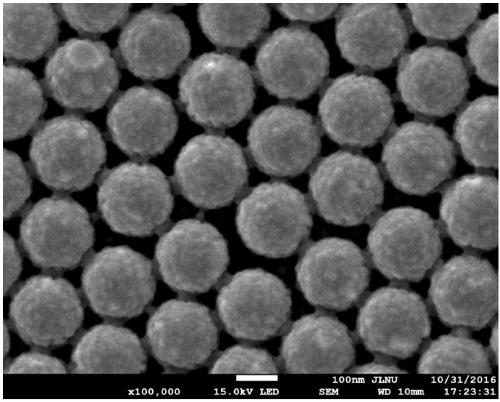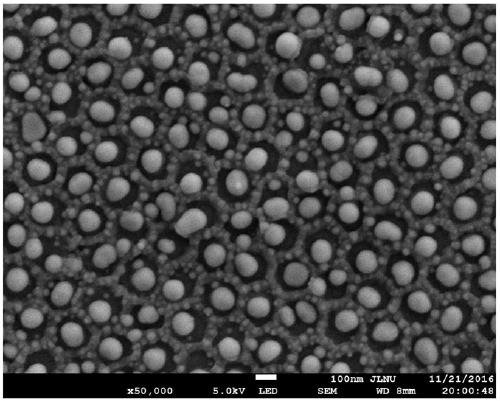A kind of honeycomb tio2-ag nanocomposite and preparation method thereof
A nanocomposite and nanocomposite technology, applied in the direction of nanotechnology, nanotechnology, nanotechnology for materials and surface science, etc., can solve problems such as the difficulty in synthesizing non-silicon-based materials, and achieve a highly ordered structure and low cost , the effect of stable performance
- Summary
- Abstract
- Description
- Claims
- Application Information
AI Technical Summary
Problems solved by technology
Method used
Image
Examples
Embodiment 1
[0023] 1. Preparation of two-dimensional ordered polystyrene colloidal arrays
[0024] A single-layer two-dimensional ordered colloidal ball template was prepared by self-assembly technology. The specific steps were: put the silicon wafer substrate in a mixed solution containing ammonia, hydrogen peroxide and water (volume ratio: 1:2:6) for 300 °C for 5-10 minutes, and then ultrasonically cleaned with deionized water and ethanol solution for 2-3 times. Soak it in 2% sodium lauryl sulfate solution for 24 hours to obtain a hydrophilic substrate surface. Take polystyrene solution and ethanol solution with a volume ratio of 1:1 and mix them, ultrasonically oscillate for 5s, then take an appropriate amount of the mixed solution and drop it on the silicon wafer substrate after hydrophilic treatment. Immerse in a container with a concentration of 12-15mmol / L NaCl saline solution. Under the action of the surface tension of the brine, the mixed solution oscillates and diffuses with th...
Embodiment 2
[0030] 1. Preparation of two-dimensional ordered polystyrene colloidal arrays
[0031] A single-layer two-dimensional ordered colloidal ball template was prepared by self-assembly technology. The specific steps were: put the silicon wafer substrate in a mixed solution containing ammonia, hydrogen peroxide and water (volume ratio: 1:2:6) for 300 °C for 5-10 minutes, and then ultrasonically cleaned with deionized water and ethanol solution for 2-3 times. Soak it in 2% sodium lauryl sulfate solution for 24 hours to obtain a hydrophilic substrate surface. Take polystyrene solution and ethanol solution with a volume ratio of 1:1 and mix them, ultrasonically oscillate for 5s, then take an appropriate amount of the mixed solution and drop it on the silicon wafer substrate after hydrophilic treatment. Immerse in a container filled with a NaCl solution with a concentration of 12-15mmol / L. Under the action of the surface tension of the brine, the mixed solution oscillates and diffuses ...
Embodiment 3
[0037] 1. Preparation of two-dimensional ordered polystyrene colloidal arrays
[0038]A single-layer two-dimensional ordered colloidal ball template was prepared by self-assembly technology. The specific steps were: put the silicon wafer substrate in a mixed solution containing ammonia, hydrogen peroxide and water (volume ratio: 1:2:6) for 300 °C for 5-10 minutes, and then ultrasonically cleaned with deionized water and ethanol solution for 2-3 times. Soak it in 2% sodium lauryl sulfate solution for 24 hours to obtain a hydrophilic substrate surface. Take polystyrene solution and ethanol solution with a volume ratio of 1:1 and mix them, ultrasonically oscillate for 5s, then take an appropriate amount of the mixed solution and drop it on the silicon wafer substrate after hydrophilic treatment. Immerse in a container with a concentration of 12-15mmol / L NaCl saline solution. Under the action of the surface tension of the brine, the mixed solution oscillates and diffuses with the...
PUM
| Property | Measurement | Unit |
|---|---|---|
| particle diameter | aaaaa | aaaaa |
| particle diameter | aaaaa | aaaaa |
| pore size | aaaaa | aaaaa |
Abstract
Description
Claims
Application Information
 Login to View More
Login to View More - R&D
- Intellectual Property
- Life Sciences
- Materials
- Tech Scout
- Unparalleled Data Quality
- Higher Quality Content
- 60% Fewer Hallucinations
Browse by: Latest US Patents, China's latest patents, Technical Efficacy Thesaurus, Application Domain, Technology Topic, Popular Technical Reports.
© 2025 PatSnap. All rights reserved.Legal|Privacy policy|Modern Slavery Act Transparency Statement|Sitemap|About US| Contact US: help@patsnap.com


